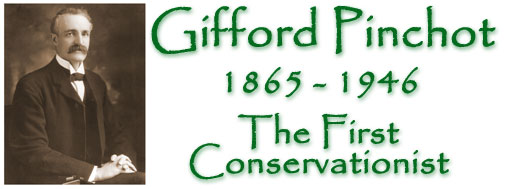
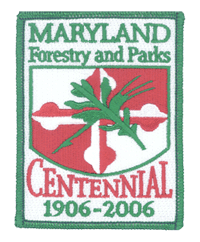
By Vaughn Deckret
How Fred W. Besley, Maryland's first state forester, became an outstanding environmental leader has much to do
with the man who inspired him-Gifford Pinchot.
Gifford Pinchot was an extraordinary man. Born to wealth and a family of culture and
connections, he chose to forgo the path of business, so successfully followed by
his father and grandfathers, to blaze new trails. On graduating from Yale in
1889, he could have pursued any profession on earth, yet Gifford Pinchot decided
to become a forester.
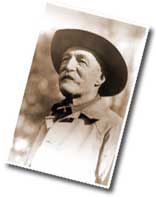 This remarkable decision had far-reaching consequences. In
the early 1890s, Pinchot (PIN-show) became the nation's first practicing
forester. In 1898, he began his 12-year career as chief of what became the U.S.
Forest Service. In 1900, he founded the Yale School of Forestry and the Society
of American Foresters.
This remarkable decision had far-reaching consequences. In
the early 1890s, Pinchot (PIN-show) became the nation's first practicing
forester. In 1898, he began his 12-year career as chief of what became the U.S.
Forest Service. In 1900, he founded the Yale School of Forestry and the Society
of American Foresters.
For bringing the profession to America and promoting the
new field relentlessly throughout his life, he is recognized as the father of
American forestry. Pioneering forestry, though, proved to be the prelude to even
greater deeds: formulating the idea of conservation as we now understand the
term and launching the conservation movement.
Spirit of the Times
Many easily
forget the degree to which natural resources were taken for granted after
Europeans colonized America. The forests were so vast, the game so plentiful,
and the bays and rivers so packed with fish and shellfish that seizing what was
wanted without a thought to future supply became a countrywide habit.
At the end
of the 1800s, settlers out West were still piling and burning saw logs just to
get rid of them. The eastern hemlock was approaching extinction as the trees
were being methodically stripped of their bark, a prized source of tannin for
the leather-making industry.
Trees, much like the oysters in our Chesapeake Bay,
were seen as inexhaustible. To displace destructive use of forests with wise use
that guarantees sustainable supply was not simply a formidable task: It was an
idea alien to nearly everyone. In this time of wanton devastation, accelerated
by advances in machinery and transportation, Gifford Pinchot came of age.
Early
Influences
Pinchot's life's work had early beginnings. As a boy, he loved the
woods and everything about them. Camping, fishing and hunting were favorite
pastimes. He talked of becoming a naturalist when he grew up. His father often
spoke of forestry and liked to quote a French intellectual who said that
neglecting forests was "not merely a blunder, but a calamity and a curse." When
Pinchot was about to begin college, his father asked him to consider forestry as
a career.
George Marsh's "Man and Nature," a gift from his parents on his 21st
birthday, profoundly influenced young Pinchot. The book attributes the collapse
of various ancient Mediterranean settlements and civilizations to deforestation
of watersheds. The ensuing erosion of fertile soil and silting of waterways and
harbors eventually destroyed their economies and social orders. Thereafter,
Pinchot never doubted the direct relation of forests to a society's welfare.
Preparing for his Life's Work
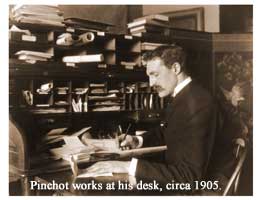 Because no schools of forestry yet existed in
America, Pinchot traveled to
Europe, sought advice from several eminent
authorities on forestry, and then enrolled in the National School of Forestry in
Nancy, France. In addition to completing its one-year program, he visited
forests all over Europe, some of the most superbly managed on earth. Among them
was the Sihlwald, a stunningly productive forest near Zurich that had been
regularly managed long before Columbus sailed west.
Because no schools of forestry yet existed in
America, Pinchot traveled to
Europe, sought advice from several eminent
authorities on forestry, and then enrolled in the National School of Forestry in
Nancy, France. In addition to completing its one-year program, he visited
forests all over Europe, some of the most superbly managed on earth. Among them
was the Sihlwald, a stunningly productive forest near Zurich that had been
regularly managed long before Columbus sailed west.
In Europe, he acquired a
grounding in silviculture (knowledge of the care and cultivation of trees), the
economics of forestry, and forestry law. There he formed a concrete
understanding of the forest as a crop. On returning home in December 1890,
Pinchot wasted no time pursuing his priorities: establishing relations with
leaders of the nascent forestry movement, practicing forestry, and seeing
America's great forests.
Crucial Experience
His work in the woods began in early
1891, when Phelps Dodge hired him to evaluate timberlands in Pennsylvania. Soon
afterwards, he was invited to accompany the chief of the U.S. Division of
Forestry on a mission to examine hardwoods in Mississippi and Arkansas. That
spring, Phelps Dodge sent him to evaluate holdings in Arizona.
As the fledgling
forester wrote, this trip gave him a chance to "shake hands with the U.S.A."
Conducting his own "grand tour," he saw the Grand Canyon, Yosemite, the giant
sequoias of the Sierras, and the towering redwoods and Douglas firs of the
Pacific coastal forests. The vastness and magnificence of the largely unspoiled
West left him in awe and heightened his sense of what was at stake.
A flood of
practical experience followed. He was hired to manage forests on George
Vanderbilt's mammoth estate in North Carolina. In late 1893, he took on
additional work as a consulting forester, applying the science of forestry in
such places as the Adirondacks of New York and the pine and white cedar woods of
New Jersey.
Of crucial importance was his appointment to the National Forest
Commission, formed to write a plan for administering all forests on U.S. public
lands. In addition to the experience evaluating western forests that were to
become 21 million additional acres of national reserves, Pinchot got an
education in the realities of politics, legislation, bureaucracy, regional
interests and the power of public opinion. Another result was that two
presidents, Grover Cleveland and William McKinley, and numerous senators,
congressmen and high-level bureaucrats became well acquainted with the energetic
and able Gifford Pinchot.
Forest of Accomplishments
When Pinchot was appointed
chief of the U.S. Division of Forestry in 1898, he was given a free hand to act
as he saw fit. So began the transformation of an insignificant federal agency
into the motherland of American forestry and incubator of the conservation
movement.
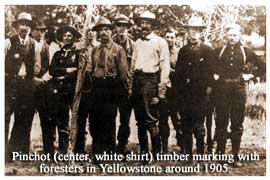 To show that practical forestry pays off, Pinchot immediately offered
forestry services to private owners and other federal agencies. This approach
was both shrewd and necessary because, as odd as it sounds, his agency had no
control over federal forests, which covered millions of acres.
To show that practical forestry pays off, Pinchot immediately offered
forestry services to private owners and other federal agencies. This approach
was both shrewd and necessary because, as odd as it sounds, his agency had no
control over federal forests, which covered millions of acres.
Pinchot knew that
to advance forestry in giant steps required a highly capable organization, so he
built one. He steadily enlarged his staff (e.g., from 11 to 179 in three years)
and included respected professors to provide scientific expertise. He rejected
the political spoils system and hired only on merit. He also demanded
professionalism in all matters. For example, all inquiries from the public and
Congress had to be answered fully and quickly, and correspondence had to be
replied to within 36 hours.
His staff became renowned for its
esprit de corps,
and his agency was widely seen as the best run in the federal government. In the
words of Stewart Udall, Secretary of the Interior in the early 1960s, Pinchot
made the U.S. Forest Service "in his time the most exciting organization in
Washington."
Throughout his years in Washington, Pinchot energetically
cultivated political and public support for his agency's work and its mission,
and he used the press as his primary means. To pursue favorable publicity, he
set up an in-house press bureau. He even used a new mailing label machine to
send reports and press releases to thousands of selected individuals, groups and
newspapers.
The broad support he generated coupled with President Theodore
Roosevelt's vigorous backing gave Pinchot one of his greatest successes. In
1905, Congress agreed to transfer all national forest reserves, soon renamed
national forests, from the Department of the Interior to his agency in
Agriculture. This transfer allowed him to practice forestry on millions of
federal acres and put an end to decades of forest devastation.
During his
tenure, Pinchot increased the number of national forests from 32 to 149 and
their acreage to 193 million. Today these public lands continue to serve
multiple purposes, including watershed protection, habitat and wilderness
preservation, outdoor recreation, and timber production.
Birth of Conservation
Because of his work in forestry, Gifford Pinchot was able to bring the principle
and policy of conservation into the world.
In the early 1900s, more than 20
federal agencies dealt with natural resources. Though their responsibilities
often overlapped, each agency pursued its own objectives, and little cooperation
occurred among them. Because President Teddy Roosevelt routinely conducted much
of his business with these agencies through Pinchot, who was his friend and
advisor, the chief forester became familiar with mining, agriculture,
irrigation, stream flow, soil erosion, fish, game and other resource matters
like no one else in Washington.
On a February day in 1907, Pinchot went for a
solitary ride on horseback to get away from work, but he found himself thinking
about the spectrum of natural resources-water, soil, wildlife, plants, trees and
minerals-on which our lives depend. Considering the interlocking relations among
them and that all were parts of a whole, it dawned on him that what bound all
resources together was the problem of use.
As a forester, he knew that wise use was the answer to devastation. In a leap of
imagination, he saw that an extrapolation of the idea to all resources was the key
to the future. He later remarked that "unless we practice conservation, those
who come after us will have to pay the price of misery, degradation and failure
for the progress and prosperity of our day."
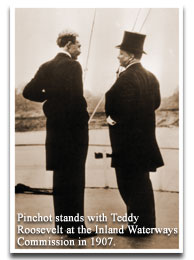 Pinchot derived the name for his idea from
"conservancy," the term for a large tract of forest land managed by a
"conservator" in British India. Conservation-the management, restoration,
protection and preservation of natural resources-was his prescription for
finding a balance between human activity and the workings of nature.
Pinchot derived the name for his idea from
"conservancy," the term for a large tract of forest land managed by a
"conservator" in British India. Conservation-the management, restoration,
protection and preservation of natural resources-was his prescription for
finding a balance between human activity and the workings of nature.
When Pinchot brought his "big picture" idea to the president, Roosevelt immediately
grasped its importance. Then and there, he made it the policy of his
administration, and conservation soon became a household word.
Enduring Legacy
Though most Americans today know little about Gifford Pinchot and his launching
of the conservation movement, his legacy endures. Most of our national forests
exist largely because of his persistence. Institutions he founded 100 years ago continue to pursue their missions. Moreover, there are the countless
conservationists who have been inspired by his character, spirit, vision and
leadership.
Fred Besley was among them. Besley worked for Pinchot as a student
assistant, graduated from the Yale School of Forestry, was appointed Maryland's
first state forester in 1906, and went on to establish our state's system of
forests and parks, mirroring in part Pinchot's work for the nation. Steve Koehn,
who directs DNR's Forest Service and so holds Besley's job today, is himself a
disciple of Pinchot.
Of
course, the overarching element of his legacy is conservation itself, the core
idea guiding natural resource agencies throughout the country. In Maryland, DNR
is working diligently to replenish bay grasses, restore the oyster population,
reduce nutrient runoff, and protect the Chesapeake Bay watershed. There may be
no finer way of honoring our first conservationist than putting his idea into
practice.
Fred W.
Besley
(1872-1960)
Maryland Pioneer in Forest Conservation
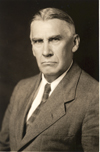 In
1906, John and Robert Garrett, heirs of the B&O Railroad fortune, donated
2000 acres to Maryland on condition that the state set up a forestry
department to manage the bequest, now known as Garrett State Forest.
Maryland responded by establishing the Board of Forestry and by hiring Fred
W. Besley, our first state forester.
In
1906, John and Robert Garrett, heirs of the B&O Railroad fortune, donated
2000 acres to Maryland on condition that the state set up a forestry
department to manage the bequest, now known as Garrett State Forest.
Maryland responded by establishing the Board of Forestry and by hiring Fred
W. Besley, our first state forester.
Besley had graduated from
Maryland Agriculture College at the University of Maryland. After first
meeting Gifford Pinchot, chief of the U.S. Division of Forestry, he wrote, "Pinchot
was so boiling over with enthusiasm about forestry that then and there I
adopted forestry as my career."
1900 - Hired by
Pinchot as a student assistant for fieldwork at $25 a month; assigned to
survey timber in New York, Michigan, and Kentucky
1903 - Graduated cum
laude with a master's degree from the Yale School of Forestry
1906 - Appointed the
first state forester of Maryland; served 36 years
1913 - Began the
Timber Marking Plan, a program providing private landowners with assistance
in designating trees suitable for harvest; this practice became standard
throughout the country
1916 - Published
"The Forests of Maryland," the first comprehensive survey of forest
resources conducted by any state; later wrote, "I trampled every cow path in
Maryland making it"
1924 - Initiated the
first statewide Big Tree Contest; worked with the American Forestry
Association to launch the national Big Tree Contest in 1940 (Maryland's Wye
Oak held title as the nation's largest white oak until its toppling in 2002)
Note: This article originally appeared in the Fall 2004
issue of The Maryland Natural Resource magazine.